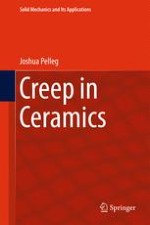1 there is an enhanced role of diffusion creep and 2 in the power law regime ceramics divide into two categories with stress exponents of 5 and 3 respectively.
Theories of creep in ceramics.
For the case of lamellae parallel to the stress axis ϕ 0 redistribution of stress must occur in the duplex structure because the creep resistance of the matrix tial is different from that of the reinforcement ti 3 al.
Mathematical models that have been proposed for creep in ceramics are described.
In ceramics with high glass contents creep is controlled by the viscous flow of glass.
In lifshitz models the crystalline grains elongate with strain.
The ironing effect of the moving wheels on the wave formed in the rail causes a longitudinal movement of the rail in the direction of traffic resulting in the creep of the rail fig.
2 percussion theory according to percussion theory creep is developed due to the impact of wheels at the rail end ahead of a joint.
In lifshitz models the crystalline grains elongate with strain.
The elongation results from diffusion slip or solution and precipitation.
Emphasis is on models involving grain boundary motion sliding or flow.
We consider electric creep to be a time dependent process with an initial condition lying on the d electric displacement versus e electric field hysteresis loop.
Metals and ceramics exhibit diffusion creep with n 1 at low stresses and n 3 at high stresses.
Referring to the creep models proposed for composite materials the creep model for the dual phase lamellar micro structure has been established 28 29.
This discrepancy in results is believed to be a consequence of the fact that ceramics tend to creep more readily in tension than in compression leading to a shift in the neutral plane for stress and strain in flexural specimens which results in extended primary creep.
Viscosity and in turn creep rate will depend on the composition of the glassy phase and its temperature.
Creep both in metals and ceramics in the steady state is diffusion controlled and the homologue temperature of t t m regarding the diffusion coefficient also applies to both materials.
Emphasis is on models involving grain boundary motion sliding or flow.
It is demonstrated that there are two important differences in the creep behaviour of ceramics.
In this paper we present a theory of electric creep and related electromechanical coupling for both non poled and fully poled ferroelectric ceramics.
The elongation results from diffusion slip or solution and precipitation.





























